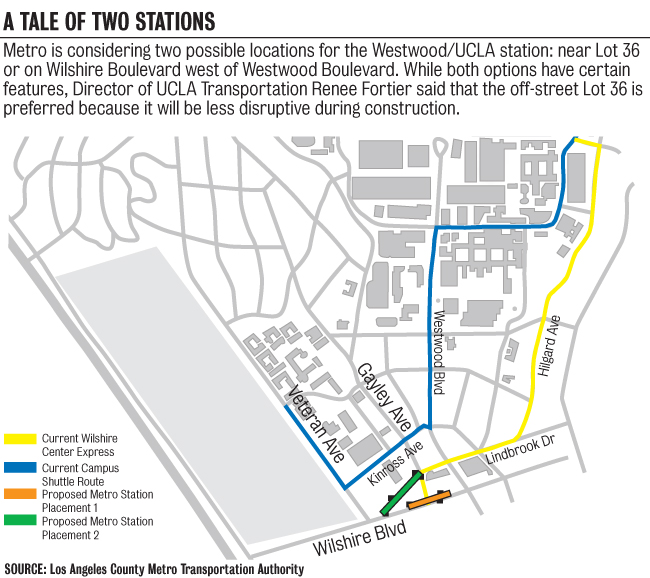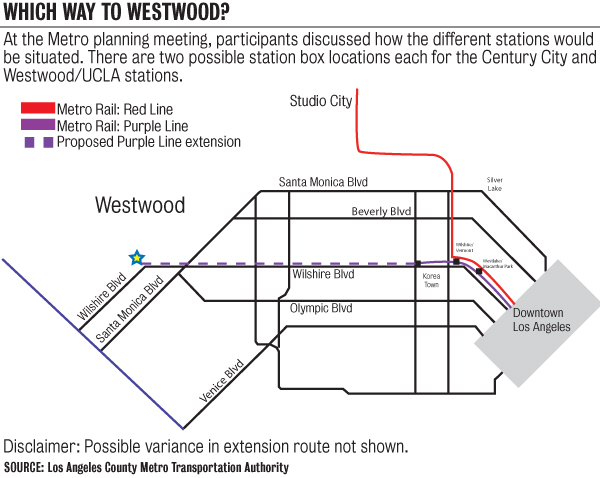
UCLA students expressed both their encouragement and concern for the Westside subway extension at a Los Angeles County Metropolitan Transportation Authority station-planning meeting on Nov. 5, highlighting students’ current need for more efficient transportation.
“Most of the students (at UCLA) don’t have a car because there’s nowhere to park, so (the subway) would be a great transportation alternative,” said Chris Santiago, a second-year geography student who attended the meeting.
Santiago is a member of Bruins for Traffic Relief, a student group on campus dedicated to giving students more exposure to public transit and getting better public transportation in Los Angeles.
“We understand that a lot of UCLA students have to travel long distances to get to the campus,” said David Mieger, director of the Westside extension project for MTA. “If you can get from downtown to Westwood in 30 minutes by (subway) versus 45 minutes by car or bus, we think that will be a real advantage for folks trying to commute to UCLA.”
While some students expressed interest in a Westwood subway, others disagreed about the need for the project right now, citing the current economic problems the U.S. is facing.
“It would be the wrong time to try to pursue some sort of expensive program that isn’t a necessity, considering that we’re going through an economic tough time,” said Sina Safvati, a first-year history student. “It’s not fiscally disciplined.”
In addition, some Westwood residents who participated at the meeting were concerned about the impact the subway would have on their homes. Discussion became heated in regard to the subway’s location, as residents were worried about the possibility of noise disruption and vibrations in the ground from the subway.
The Westside subway proposal would extend the Purple Line from Wilshire Boulevard and Western Avenue all the way to Westwood Boulevard. Held at the Wadsworth Theatre, the Metro planning meeting included discussion about the features of the two options for the Westwood/UCLA station.
The first option is to place the station box off-street, below the UCLA-owned Lot 36. The second would locate the station on-street, under Wilshire Boulevard, west of Westwood Boulevard.
While meeting participants seemed to back both options, Lot 36 had somewhat more support from students and the university administration.
“The advantage of the (option) that is on the UCLA property is that it will be much less disruptive during construction for everyone,” said Renee Fortier, director of UCLA Transportation Services.
Mieger agreed, explaining that off-street construction would have much less of an impact on the community. In comparison, if the Wilshire option is chosen, concrete slabs will be placed over the street to allow people to commute while construction is going on.
Furthermore, the parking lot’s proximity to the stop for UCLA’s Campus Express shuttle is an advantage in the eyes of some students.
“I’m in favor of the Lot 36 alternative, because (the city) can concentrate all of the construction in that parking lot,” Santiago said. “(Also), it’s slightly closer to the apartments and the dorms. It’s right next to the campus shuttle and the FlyAway (shuttle to the Los Angeles International Airport).”
Students have a variety of reasons for using the subway, from exploring Los Angeles to commuting home quickly.
Santiago said the subway would not only make trips to Koreatown or downtown easier, but would also make commuting home more efficient. A Diamond Bar resident, Santiago goes home every weekend by car, but does not leave until late at night due to traffic. By public transportation, it can take up to three hours to get home, he said.
“With the subway, you don’t have to worry about traffic,” Santiago said. “It’s independent of the road system.”
However, other students said they did not support the subway extension, specifically due to the increased traffic and disruption construction would cause.
“I think that not a lot of people are going to take advantage of this service and most people are still going to use their cars,” Safvati said. “I think (the subway) will help UCLA students who don’t live on campus and I think they’re going to use it.”
Safvati, who drives every day from West Los Angeles, said he would not use the subway because it is out of his way.
Nevertheless, the concerns about traffic and congestion in Los Angeles are one of the many factors driving the subway project.
“The traffic is getting to really intense levels, so this (subway) is a way we can carry more people without adding more cars to the surface,” Mieger said. “It’s something we need today, but in the future as we get more people and more growth, this would be a way to accommodate more people without bringing a lot more cars into this area that’s so congested.”
For the Purple Line to extend all the way to the proposed Westwood/UCLA station, it will cost about $4.2 billion in 2008 dollars, so the cost will change with inflation, Mieger said. The Measure R sales-tax increase will help fund the project, but MTA is also looking for federal matching funds so that the subway will be built sooner.
“We wouldn’t start construction in Westwood until probably 2026 or 2028,” Mieger said. “We know we have enough money to get it as far as Westwood, but we’re trying to see if we have additional funds so we can get it built sooner.”
Second-year political science student and Bruins for Traffic Relief President Matthew Kroneberger, who worked for MTA as a communications intern this past summer, was involved specifically with the subway project.
“There is no question that the baseline of the Westside extension will always include a Westwood/UCLA station,” Kroneberger said. “It’s not just based on bias, but rather on the projected high ridership, high utility and fundamental need for a Westwood station.”
With 65,000 people coming on campus every day, Fortier expects the subway to affect people’s mobility and that it will be “absolutely critical because L.A. is going to grow.”
Referring to UCLA Transportation surveys conducted every spring, Fortier said that of the staff, faculty and students who commute to campus, 21 percent use public transit.
Considering the vast number of people on campus everyday, the Westwood/UCLA subway station would likely be the third or fourth highest in usage in the entire MTA system, MTA regional communications manager Jody Litvak said at the meeting.
Despite the heavy demand this station would create, Mieger said that in the most optimistic scenario, construction for the Westside extension would not begin for at least four years.
Furthermore, the caveat is that construction would begin on the parts of the subway closer to Wilshire and Western, not necessarily the Westwood/UCLA station.
Without federal funding, the Westwood/UCLA station would open around 2036 on this time frame, Mieger said. However, he added that the subway could be built in 10 years if the money were available today.
Students remain undeterred by the lengthy process demanded in such a complex project.
“When the subway is built, it will not only transform the way we get around, it will change the way we interact with the city of L.A.,” Kroneberger said.
